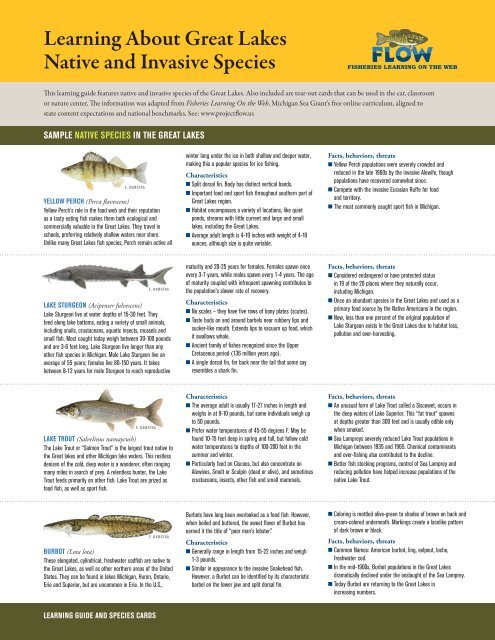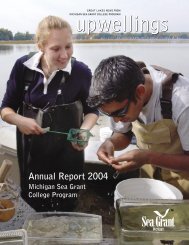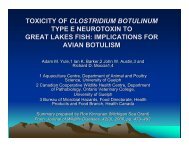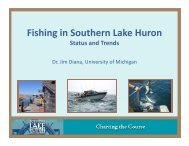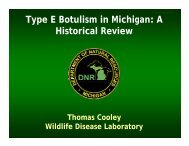Learning About Great Lakes Native and Invasive Species
Learning About Great Lakes Native and Invasive Species
Learning About Great Lakes Native and Invasive Species
- No tags were found...
Create successful ePaper yourself
Turn your PDF publications into a flip-book with our unique Google optimized e-Paper software.
<strong>Learning</strong> <strong>About</strong> <strong>Great</strong> <strong>Lakes</strong><strong>Native</strong> <strong>and</strong> <strong>Invasive</strong> <strong>Species</strong>FISHERIES LEARNING ON THE WEBThis learning guide features native <strong>and</strong> invasive species of the <strong>Great</strong> <strong>Lakes</strong>. Also included are tear-out cards that can be used in the car, classroomor nature center. The information was adapted from Fisheries <strong>Learning</strong> On the Web, Michigan Sea Grant’s free online curriculum, aligned tostate content expectations <strong>and</strong> national benchmarks. See: www.projectflow.usSAMPLE NATIVE SPECIES IN THE GREAT LAKESE. DAMSTRAYELLOW PERCH (Perca fl avescens)Yellow Perch’s role in the food web <strong>and</strong> their reputationas a tasty eating fi sh makes them both ecological <strong>and</strong>commercially valuable in the <strong>Great</strong> <strong>Lakes</strong>. They travel inschools, preferring relatively shallow waters near shore.Unlike many <strong>Great</strong> <strong>Lakes</strong> fi sh species, Perch remain active allwinter long under the ice in both shallow <strong>and</strong> deeper water,making this a popular species for ice fi shing.Characteristics■ Split dorsal fi n. Body has distinct vertical b<strong>and</strong>s.■ Important food <strong>and</strong> sport fi sh throughout southern part of<strong>Great</strong> <strong>Lakes</strong> region.■ Habitat encompasses a variety of locations, like quietponds, streams with little current <strong>and</strong> large <strong>and</strong> smalllakes, including the <strong>Great</strong> <strong>Lakes</strong>.■ Average adult length is 4-10 inches with weight of 4-10ounces, although size is quite variable.Facts, behaviors, threats■ Yellow Perch populations were severely crowded <strong>and</strong>reduced in the late 1960s by the invasive Alewife, thoughpopulations have recovered somewhat since.■ Compete with the invasive Eurasian Ruffe for food<strong>and</strong> territory.■ The most commonly caught sport fi sh in Michigan.E. DAMSTRALAKE STURGEON (Acipenser fulvescens)Lake Sturgeon live at water depths of 15-30 feet. Theyfeed along lake bottoms, eating a variety of small animals,including snails, crustaceans, aquatic insects, mussels <strong>and</strong>small fi sh. Most caught today weigh between 30-100 pounds<strong>and</strong> are 3-6 feet long. Lake Sturgeon live longer than anyother fi sh species in Michigan. Male Lake Sturgeon live anaverage of 55 years; females live 80-150 years. It takesbetween 8-12 years for male Sturgeon to reach reproductivematurity <strong>and</strong> 20-25 years for females. Females spawn onceevery 3-7 years, while males spawn every 1-4 years. The ageof maturity coupled with infrequent spawning contributes tothe population’s slower rate of recovery.Characteristics■ No scales – they have fi ve rows of bony plates (scutes).■ Taste buds on <strong>and</strong> around barbels near rubbery lips <strong>and</strong>sucker-like mouth. Extends lips to vacuum up food, whichit swallows whole.■ Ancient family of fi shes recognized since the UpperCretaceous period (136 million years ago).■ A single dorsal fi n, far back near the tail that some sayresembles a shark fi n.Facts, behaviors, threats■ Considered endangered or have protected statusin 19 of the 20 places where they naturally occur,including Michigan.■ Once an abundant species in the <strong>Great</strong> <strong>Lakes</strong> <strong>and</strong> used as aprimary food source by the <strong>Native</strong> Americans in the region.■ Now, less than one percent of the original population ofLake Sturgeon exists in the <strong>Great</strong> <strong>Lakes</strong> due to habitat loss,pollution <strong>and</strong> over-harvesting.E. DAMSTRALAKE TROUT (Salvelinus namaycush)The Lake Trout or “Salmon Trout” is the largest trout native tothe <strong>Great</strong> lakes <strong>and</strong> other Michigan lake waters. This restlessdenizen of the cold, deep water is a w<strong>and</strong>erer, often rangingmany miles in search of prey. A relentless hunter, the LakeTrout feeds primarily on other fi sh. Lake Trout are prized asfood fi sh, as well as sport fi sh.Characteristics■ The average adult is usually 17-27 inches in length <strong>and</strong>weighs in at 9-10 pounds, but some individuals weigh upto 50 pounds.■ Prefer water temperatures of 45-55 degrees F. May befound 10-15 feet deep in spring <strong>and</strong> fall, but follow coldwater temperatures to depths of 100-200 feet in thesummer <strong>and</strong> winter.■ Particularly feed on Ciscoes, but also concentrate onAlewives, Smelt or Sculpin (dead or alive), <strong>and</strong> sometimescrustaceans, insects, other fi sh <strong>and</strong> small mammals.Facts, behaviors, threats■ An unusual form of Lake Trout called a Siscowet, occurs inthe deep waters of Lake Superior. This “fat trout” spawnsat depths greater than 300 feet <strong>and</strong> is usually edible onlywhen smoked.■ Sea Lampreys severely reduced Lake Trout populations inMichigan between 1935 <strong>and</strong> 1965. Chemical contaminants<strong>and</strong> over-fi shing also contributed to the decline.■ Better fi sh stocking programs, control of Sea Lamprey <strong>and</strong>reducing pollution have helped increase populations of thenative Lake Trout.E. DAMSTRABURBOT (Lota lota)These elongated, cylindrical, freshwater codfi sh are native tothe <strong>Great</strong> <strong>Lakes</strong>, as well as other northern areas of the UnitedStates. They can be found in lakes Michigan, Huron, Ontario,Erie <strong>and</strong> Superior, but are uncommon in Erie. In the U.S.,Burbots have long been overlooked as a food fi sh. However,when boiled <strong>and</strong> buttered, the sweet fl avor of Burbot hasearned it the title of “poor man’s lobster.”Characteristics■ Generally range in length from 15-22 inches <strong>and</strong> weigh1-3 pounds.■ Similar in appearance to the invasive Snakehead fi sh.However, a Burbot can be identifi ed by its characteristicbarbel on the lower jaw <strong>and</strong> split dorsal fi n.■ Coloring is mottled olive-green to shades of brown on back <strong>and</strong>cream-colored underneath. Markings create a lacelike patternof dark brown or black.Facts, behaviors, threats■ Common Names: American burbot, ling, eelpout, loche,freshwater cod.■ In the mid-1900s, Burbot populations in the <strong>Great</strong> <strong>Lakes</strong>dramatically declined under the onslaught of the Sea Lamprey.■ Today Burbot are returning to the <strong>Great</strong> <strong>Lakes</strong> inincreasing numbers.LEARNING GUIDE AND SPECIES CARDSwww.miseagrant.umich.eduMICHIGAN SEA GRANT5
SAMPLE NATIVE SPECIES IN THE GREAT LAKESE. DAMSTRAMUSKELLUNGE (Esox masquinongy)Often called Muskie, these relatively rare freshwater fi share the largest member of the pike family. The nameMuskellunge comes from the Ojibwe word maashkinoozhe,roughly translating to “ugly pike.” They closely resemble theNorthern Pike in both appearance <strong>and</strong> behavior. Their bodiesare elongated with fl at heads <strong>and</strong> dorsal, pelvic <strong>and</strong> anal fi nsset far back of the head. A Muskie has large powerful jawsshaped like a duckbill, armed with numerous fang-like teeth.Characteristics■ Size varies greatly by lake, but range from 2-5 feet <strong>and</strong>average 20 pounds. Large fi sh can weigh 40-60 pounds.■ <strong>Great</strong> <strong>Lakes</strong> Muskie are a light silver, brown or greenwith dark vertical markings, which tend to break up intospots. In contrast, Northern Pike have dark bodies withlight markings.■ To tell a Muskie from a Northern Pike, count the pores onthe underside of the jaw. A Muskie has six or more. A Pikenever has more than fi ve.Facts, behaviors, threats■ Second only to Sturgeon as the <strong>Great</strong> <strong>Lakes</strong>’ largest fi sh.■ Commonly known as “the fi sh of 10,000 casts” to anglersbecause it can take an average of 50-80 hours of fi shingtime to get one on the line.■ Hunt by staying motionless <strong>and</strong> when prey swims by, theypierce it with their large canines, rotate it <strong>and</strong> swallow ithead fi rst.E. DAMSTRALONGNOSE GAR (Lepisosteus osseus)The Gar can be found in all of the <strong>Great</strong> <strong>Lakes</strong> exceptSuperior. Gar have remained largely the same since the daysof the dinosaur. An inhabitant of warm, quiet waters, theGar is known for its sharp teeth <strong>and</strong> aggressive nature. Theycatch their prey sideways in their toothy jaws by stayingmotionless or slowly stalking prey. The Gar slashes its beakfrom side-to-side like scissors when it grabs prey, sometimescutting it in half.Characteristics■ Has a thin, long body covered with hard diamond-shapedscales. Its pointy mouth is fi lled with teeth.■ Average fi sh is about 30 inches long, about 20 pounds <strong>and</strong>can live to be about 20 years old.Facts, behaviors, threats■ Historically, <strong>Native</strong> Americans used the heavy, toughrhomboid scales of the gar for arrow points, ornament,<strong>and</strong> other instruments.■ Can take in oxygen by swimming to the surface <strong>and</strong>gulping air into their swim bladders. This characteristicallows them to survive in water that has almost no oxygen<strong>and</strong> they can live out of water for hours, as long as theirbodies stay moist.KURT STEPNITZ, MSUPLAIN POCKETBOOK MUSSEL (Lampsilis cardium)The pocketbook is a native mussel found in lakes, streams <strong>and</strong>rivers, in mud, s<strong>and</strong> <strong>and</strong> gravel. In Michigan, the pocketbookis found throughout both the Upper <strong>and</strong> Lower peninsulas.Mussels like the plain pocketbook need fi sh to help themdevelop. Fertilized eggs are grown into larvae inside the femalemussel. The larvae, called glochidia, are then released into thewater where they must attach to a host fi sh, The larvae liveon the gill fi laments or the body of a host fi sh for a few daysor weeks <strong>and</strong> are then sloughed off as free-living organisms.Characteristics■ The periostracum (outer shell layer) is smooth, yellow toyellow-green with green rays, although sometimes raysare absent.■ The pocketbook is up to 7 inches long, <strong>and</strong> is round orquadrate in shape.■ In Michigan, this species can be confused with othernative mussels like the mucket, fat mucket, or wavy-rayedlampmussel.Facts, behaviors, threats■ Female has a distinct mantle fl ap, which resembles aminnow. The minnow mimic lures fi sh to chew on the fl ap<strong>and</strong> break the membrane, releasing the mussel larvae <strong>and</strong>helping in the reproductive cycle.■ Can be colonized <strong>and</strong> smothered by the invasivezebra mussel.■ Competes with zebra <strong>and</strong> quagga mussels for food.BRENNERPRICKLY WILD ROSE (Rosa acicularis)This native rose grows in gravel, s<strong>and</strong>y shores, dunes, moistthickets <strong>and</strong> swamps. It can also be found inl<strong>and</strong> mixed intos<strong>and</strong>y oak <strong>and</strong> jack pine st<strong>and</strong>s. It is the only rose native toMichigan that can also be found in Europe <strong>and</strong> Asia <strong>and</strong> hasthe largest range of all the rose species. True to its name,the stems have many slender, unequal prickles. It generallyfl owers from late May to late July with smooth fruits – or rosehips – developing in the late summer.Characteristics■ Flowers have fi ve pink or deep rose-colored petals.■ Many of the shrubs grow together because they areclonal – meaning groups of plants share undergroundconnections.■ Grows low to the ground <strong>and</strong> helps stabilize the shiftings<strong>and</strong>s of the beach.■ Moderately fi re resistant. Can sprout from the base offi re-killed stems or from rhizomes.Facts, behaviors, threats■ Many animals <strong>and</strong> birds eat the fruits of the plant, whichstay on the stems well into the winter months. The ruffedgrouse is particularly fond of eating the hips.■ People make the rose hips into jellies, syrups <strong>and</strong> teas<strong>and</strong> they have also been used in mixtures to treat thingslike bee stings, cough, colds, diarrhea, sore eyes <strong>and</strong>stomach problems.■ Also used to ward off witchcraft.Sources: Guide to <strong>Great</strong> <strong>Lakes</strong> Coastal Plants - by Ellen Elliott Weatherbee, Fisheries <strong>Learning</strong> on the Web (FLOW), The <strong>Great</strong> <strong>Lakes</strong> Fishery Commission,Michigan Natural Features Inventory, U.S. Department of Agriculture, Minnesota Sea Grant <strong>and</strong> Wisconsin Sea Grant.6LEARNING upwellings GUIDE AND SPECIES CARDSVolume 32 | Number 3 | October 2009
ACTIVITYTear out cards, mix up with <strong>Invasive</strong> <strong>Species</strong> cards, <strong>and</strong> work with a group to complete the information on the back.COPY MASTERE. DAMSTRAE. DAMSTRAE. DAMSTRAE. DAMSTRASAMPLE NATIVE SPECIES IN THE GREAT LAKES www.projectfl ow.usE. DAMSTRAE. DAMSTRAFISHERIES LEARNING ON THE WEBBRENNERKURT STEPNITZ, MSUwww.miseagrant.umich.eduMICHIGAN SEA GRANT7
FISHERIES LEARNING ON THE WEBName: ___________________________________Scientific name: ____________________________<strong>Native</strong> to the <strong>Great</strong> <strong>Lakes</strong>? ____________________■ Do these fish like to swim alone or in schools?■ True or false: This fish stops eating in the winter.■ How large does an average specimen get?Michigan Sea Grant | www.projectfl ow.usName: ___________________________________Scientific name: ____________________________<strong>Native</strong> to the <strong>Great</strong> <strong>Lakes</strong>? ____________________■ Discuss: How is this fish different from other fish inthe <strong>Great</strong> <strong>Lakes</strong>?■ How big do they get? What is an average size?■ How long do they live? How does that affectthe population?■ What are some major threats to this fish?Michigan Sea Grant | www.projectfl ow.usName: ___________________________________Scientific name: ____________________________<strong>Native</strong> to the <strong>Great</strong> <strong>Lakes</strong>? ____________________■ What does this fish like to eat?■ What other species devastated this population of fish?■ Do these fish like cold water? How do we know?Name: ___________________________________Scientific name: ____________________________<strong>Native</strong> to the <strong>Great</strong> <strong>Lakes</strong>? ____________________■ What are some other names for this fish?■ Where can this species be found?■ Can you describe its fin structure?Michigan Sea Grant | www.projectfl ow.usMichigan Sea Grant | www.projectfl ow.usSAMPLE NATIVE SPECIES IN THE GREAT LAKES www.projectfl ow.us8Name: ___________________________________Scientific name: ____________________________<strong>Native</strong> to the <strong>Great</strong> <strong>Lakes</strong>? ____________________■ What do anglers call this fish? Why?■ How can you tell this species apart from other similarfish species?■ True or false: This is the largest fish in the <strong>Great</strong> <strong>Lakes</strong>.Michigan Sea Grant | www.projectfl ow.usName: ___________________________________Scientific name: ____________________________<strong>Native</strong> to the <strong>Great</strong> <strong>Lakes</strong>? ____________________■ Where is this species of mollusk found?■ What other species is a problem for this mollusk?■ How does it reproduce?Michigan Sea Grant | www.projectfl ow.usupwellingsVolume 32 | Number 3 | October 2009Name: ___________________________________Scientific name: ____________________________<strong>Native</strong> to the <strong>Great</strong> <strong>Lakes</strong>? ____________________■ What is special about the way this fish breathes?■ What is it known for?■ Does it have soft scales or hard scales?Michigan Sea Grant | www.projectfl ow.usName: ___________________________________Scientific name: ____________________________<strong>Native</strong> to the <strong>Great</strong> <strong>Lakes</strong>? ____________________■ Where might you find this species?■ What purpose does it serve?■ What did people use it for?Michigan Sea Grant | www.projectfl ow.us
ACTIVITYTear out cards, mix up with <strong>Native</strong> <strong>Species</strong> cards, <strong>and</strong> work with a group to complete the information on the back.COPY MASTERE. DAMSTRAE. DAMSTRA E. DAMSTRABRENNERSAMPLE INVASIVE SPECIES IN THE GREAT LAKES www.projectfl ow.usDAVE JUDESIMON VAN MECHELENVACCAROFISHERIES LEARNING ON THE WEBBRENNERLAPORTEBRENNERwww.miseagrant.umich.eduMICHIGAN SEA GRANT9
FISHERIES LEARNING ON THE WEBName: __________________________________Scientific name: ___________________________<strong>Native</strong> to the <strong>Great</strong> <strong>Lakes</strong>? ___________________■ These organisms are distantly related to what?■ When clumps of these get caught on a fishing line,what does it feel like when you touch them?■ Are these easy to spot floating around?■ Do fish like to eat them?Michigan Sea Grant | www.projectfl ow.usName: _________________________________Scientific name: __________________________<strong>Native</strong> to the <strong>Great</strong> <strong>Lakes</strong>? __________________■ On average, one of these fish species can destroyhow many pounds of fish?■ How does this affect the aquatic ecosystem?■ They especially like what other kinds of fish?■ Are their populations growing or shrinking in the<strong>Great</strong> <strong>Lakes</strong>?Michigan Sea Grant | www.projectfl ow.usName: ___________________________________Scientific name: ____________________________<strong>Native</strong> to the <strong>Great</strong> <strong>Lakes</strong>? ____________________■ What is the average size of these fish?■ How can you tell them apart from other similar fish?■ Do they cause problems for other fish species? How?■ Where can they be found <strong>and</strong> how did they get there?Name: __________________________________Scientific name: ___________________________<strong>Native</strong> to the <strong>Great</strong> <strong>Lakes</strong>? ___________________■ Where will you likely find these fish?■ Will they only swim in clean water?■ They resemble some other aquatic creature.What is it?■ How aggressive is this species?Michigan Sea Grant | www.projectfl ow.usMichigan Sea Grant | www.projectfl ow.usSAMPLE INVASIVE SPECIES IN THE GREAT LAKES www.projectfl ow.us10Name: __________________________________Scientific name: ___________________________<strong>Native</strong> to the <strong>Great</strong> <strong>Lakes</strong>? ___________________■ Is this species solitary or do they appear in clusters?■ True or false: they can grow to be up to 10 inchesin length.■ How did these enter the <strong>Great</strong> <strong>Lakes</strong>?■ Discuss how this species filters the water.Michigan Sea Grant | www.projectfl ow.usName: ___________________________________Scientific name: ____________________________<strong>Native</strong> to the <strong>Great</strong> <strong>Lakes</strong>? ____________________■ How tall can this plant species grow?■ Is this plant a good source of food for animals?■ Are these plants still available at garden centers <strong>and</strong>in seed mixtures?■ What impact does this plant have on other plants?Michigan Sea Grant | www.projectfl ow.usupwellingsVolume 32 | Number 3 | October 2009Name: ___________________________________Scientific name: ____________________________<strong>Native</strong> to the <strong>Great</strong> <strong>Lakes</strong>? ____________________■ What other species are related to this one?■ Name three ways this species is different fromthat relative.■ When was this species discovered in the <strong>Great</strong> <strong>Lakes</strong>?■ When these organisms move into an area, how do theyimpact the surrounding ecosystem?Michigan Sea Grant | www.projectfl ow.usName: ___________________________________Scientific name: ____________________________<strong>Native</strong> to the <strong>Great</strong> <strong>Lakes</strong>? ____________________■ What is another name for this plant?■ The majority of a mature plant can be found where –above ground or below ground?■ True or false: the only way these plants spread isthrough their seeds.■ What makes these plants particularly damaging toother plants?Michigan Sea Grant | www.projectfl ow.us
SAMPLE INVASIVE SPECIES IN THE GREAT LAKESSPINY WATER FLEA (Bythotrephes longimanus)BRENNERThe spiny water fl ea <strong>and</strong> the similar fi shhook water fl ea aredistantly related to shrimp, lobster <strong>and</strong> crayfi sh. A microscopeis needed to see them clearly. The spiny water fl ea wasdiscovered in Lake Huron in 1984. The fi shhook water fl eawas discovered in Lake Ontario in 1998.Characteristics■ Zooplankton that have long, barbed or hooked tails.■ Tails often catch on fi shing lines <strong>and</strong> downrigger cable,creating problems for anglers.■ Clumps of these zooplankton look <strong>and</strong> feel like gelatin orcotton batting.Impacts■ Eat small plankton, reducing food for native <strong>Great</strong> <strong>Lakes</strong>zooplankton.■ Not a good food source for native fi sh because their barbedtail spines are hard to digest.E. DAMSTRASEA LAMPREY (Petromyzon marinus)The Sea Lamprey is an aggressive parasitic fi sh with atoothed, round sucking mouth <strong>and</strong> rasping tongue that’s usedto bore into the fl esh of other fi sh to feed on their blood <strong>and</strong>body fl uids. They are primitive, jawless <strong>and</strong> look like eels.<strong>Native</strong> to the Atlantic Ocean, they entered the St. LawrenceRiver <strong>and</strong> eventually the <strong>Great</strong> <strong>Lakes</strong> when the Well<strong>and</strong>Canal was modernized around 1920. Today, Sea Lampreysare found in all the <strong>Great</strong> <strong>Lakes</strong> <strong>and</strong> many tributaries,with the largest population in northern Lake Huron. Throughcontrol measures, their once-exploded population has beensignifi cantly reduced – in some areas up to 90 percent ofwhat it once was.Characteristics■ Eel-like fi sh that attach to other fi sh <strong>and</strong> feed on body fl uids.■ Adults grow 12-20 inches long.■ Round, suction disk mouth is fi lled with sharp teeth.Impacts■ Can destroy 40 pounds of fi sh during its life.■ Often kills large, predator fi sh, like Lake Trout <strong>and</strong> Whitefi sh,causing populations of smaller fi sh to grow too large.■ Has contributed to declines in native fi sh populations in the<strong>Great</strong> <strong>Lakes</strong>.■ The U.S. Government spends an average of $10-15 million ayear to control Sea Lamprey.E. DAMSTRAEURASIAN RUFFE (Gymnocephalus cernuus)This small, aggressive fi sh (pronounced “rough”) with sharpspines on top <strong>and</strong> bottom fi ns, is native to Europe <strong>and</strong> Asia. Itwas fi rst discovered in Minnesota’s St. Louis River, the maintributary to western Lake Superior, in 1986. It arrived in theballast water of an ocean-going vessel.Characteristics■ Grows rapidly <strong>and</strong> loves to eat.■ Can tolerate a range of water conditions.■ The average Ruffe is 4-6 inches in length.■ Resembles Yellow Perch or small Walleye. Can bedistinguished by its fi n structure, sharp spines <strong>and</strong> the lackof scales on its head.Impacts■ Makes up an estimated 80 percent of the fi sh caught inthe St. Louis River.■ Has spread to other areas in western Lake Superior <strong>and</strong>Thunder Bay on Lake Huron.■ Because of its sheer numbers <strong>and</strong> the variety of food iteats, the Ruffe will reduce food sources for many nativefi sh, such as Walleye <strong>and</strong> Perch.E. DAMSTRAROUND GOBY (Neogobius melanostomus)This fi sh is originally from the Black <strong>and</strong> Caspian seas.They hitched a ride to the <strong>Great</strong> <strong>Lakes</strong> in the ballast waterof ocean-going vessels. Round Gobies were discovered in theSt. Clair River around 1990. They’ve now spread to all of the<strong>Great</strong> <strong>Lakes</strong>, with the greatest numbers in Lake Erie, Lake St.Clair <strong>and</strong> southern Lake Michigan.Characteristics■ Small, bottom-dwelling fi sh that resembles a large tadpole.■ Anglers are often fi rst to know when Gobies haveinvaded, as they are known to steal fi shing bait <strong>and</strong> arefrequently caught.■ Likes to live in rocky places <strong>and</strong> can survive in poorwater quality.■ Usually 3-6 inches in length, but can grow up to 10 inches.Impacts■ Displaces native fi sh, eats their eggs <strong>and</strong> young, <strong>and</strong> takesover optimal habitat.■ Spawns multiple times per season. Population grows rapidly.■ Can become the most numerous fi sh in a given area.SIMON VAN MECHELENZEBRA MUSSELS (Dreissena polymorpha)These small, striped mussels are native to the Caspian <strong>and</strong>Aral Seas of Eastern Europe <strong>and</strong> Western Asia. They traveledto the <strong>Great</strong> <strong>Lakes</strong> in the ballast water of ships. Zebra musselswere discovered in Lake St. Clair in 1988 <strong>and</strong> have spreadto all fi ve <strong>Great</strong> <strong>Lakes</strong> <strong>and</strong> many inl<strong>and</strong> lakes. They spreadprimarily by attaching to boat hulls, aquatic plants, nets,fi shing equipment, or in water <strong>and</strong> can survive for days out ofthe water given the right conditions.Characteristics■ Look like small clams with a yellowish or brownishD-shaped shell, usually with dark <strong>and</strong> light-colored stripeslike a zebra.■ Live in colonies that attach to anything solid under watersuch as submerged rocks, dock pilings, boat hulls <strong>and</strong> evennative clams <strong>and</strong> mussels, often smothering them.■ Can be up to 2 inches long, but most are about the sizeof a fi ngernail, usually grow in clusters <strong>and</strong> are generallyfound in shallow (6-30 feet), algae-rich water.Impacts■ Filter (eat) large quantities of plankton (small plants <strong>and</strong>animals), reducing food for many native species.■ Capacity to fi lter water promotes excessive growth ofaquatic plants <strong>and</strong> algae as the clearer water allows moresunlight to penetrate without as much plankton.■ Large clusters clog water intake pipes, boat motors <strong>and</strong>pumps, costing millions of dollars to control each year.■ Can wash up on shore, littering beaches with their sharpshells <strong>and</strong> creating unpleasant smells.■ Have quickly spread from the <strong>Great</strong> <strong>Lakes</strong> to many otherstates in the nation.LEARNING GUIDE AND SPECIES CARDSwww.miseagrant.umich.eduMICHIGAN SEA GRANT11


